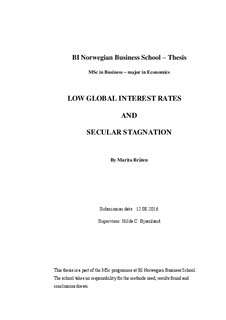| dc.description.abstract | Countries globally are currently facing low, or even negative, real interest rates. Even at this level economies are not able to reach satisfactory growth. Potential reasons are a changing savings-investment structure characterised by excess savings together with demographic factors that have led the economy into a period of persistent low values of the real interest rates, output growth and inflation. Also weak productivity growth is assumed to contribute, as it is experienced a diminishing effect of innovation compared to a few decades earlier.
This situation of low rates not being able to increase growth rates has put into light again the phenomenon of ‘secular stagnation’ – a situation where an economy re-equilibrates at a lower level of economic activity with lower demand and lower natural real interest rates. This paper draw linkages to Japan, which turns out to be far ahead compared to the rest of the world in exploring the area.
A model revealing an equilibrium of secular stagnation in A New Keynesian framework is presented. In this model, a situation of ongoing unemployment and economic stagnation seems feasible without any natural forces toward full employment.
This paper strives to determine the relationship between real interest rates and output growth in the long term. An asymmetric relationship is revealed in which a low-rate regime is characterised by a positive relation. Furthermore, in addition to depressing economic growth further, lower real interest rates are found to increase credit growth, an important determinant of financial instability.
The results are discussed in a financial setting focusing on the much debated phenomenon that low interest rates may lead to financial instability. Low interest rates drives up asset prices as investors seek yield and make rational bubbles feasible.
Policy implications are also discussed. Monetary policy turns out less effective as nominal interest rates moves toward values close to zero. The paper discusses policy implications both in regard to monetary and fiscal policy, where fiscal policy turns out as being a much more effective tool. | nb_NO |
